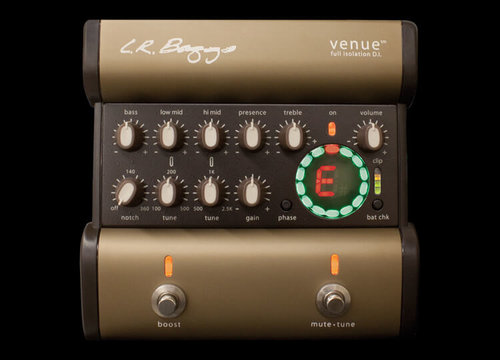How I Amplify My Fiddles Part Two: Preamps
"Where do I plug this thing in?"
In part one, I wrote about the pickups I use on my fiddles. In this post I’ll discuss what happens next, or “Where do I plug this thing in?”
Why use a preamp? Tone control, signal boosting, and impedance matching. The first two reasons make intuitive sense. I won't go into detail on impedance matching, but it's basically transforming the signal your pickup produces into something that plays nice with other sound equipment.
(I'm not paid by any of the companies I mention to promote their products, though I have included affiliate links to Amazon.)
L.R. Baggs Venue DI

The L.R. Baggs Venue DI preamp
With the pickups I’m using, it helps to plug into an active DI to boost the signal before it is sent out to an amp or the mixing console. Many DIs of this type allow some equalization (EQ), so you can adjust the sound of your fiddle and send a clean signal to the next link in the chain.
My current choice for this task is the L.R. Baggs Venue DI. This DI has lots of EQ options (bass, low mid, hi mid, treble, presence, and a notch filter), gain, an effects loop, a ground lift, phase switch, a tuner, and an adjustable boost for soloing. The tuner and boost are controlled by foot switches. It’s powered by a 9V battery or power supply (not included) and comes with a soft case for protection and transport. Let’s look at each feature separately (you can get more detail from the manual):
Equalizer — Does your fiddle have a pronounced low end, a troublesome high end, or other frequencies that pop out? The EQ options can handle this for you. Both mid-EQs are sweepable (adjustable frequency) so you have lots of control. The Notch can help with eliminating feedback, though I’ve never had to use it. Presence is also an EQ control, set between the high-mid and treble, which can help with some of the fiddle overtones.
Gain - You can get plenty of gain out of this box for a fiddle. I typically have it set at 1-3 “notches” up. The clip meter helps you set the gain; seeing too much red, or it’s clipping/sounds bad? Turn the gain down.
Boost - Easy to use, this boost helps pump it up if you need more signal for a solo. A few dB is probably enough — make sure to sound check with boost on and off if you’re using it!
Tuner - This is the weak point for me. In my experience, the tuner isn’t fast or accurate enough. I think this is related to its being designed for guitarists. Bummer.
Ground lift - If you're hearing a humming sound, try flipping this switch.
Phase - Depending on where you are relative to the sound source (speakers or amp or both), one of the settings of this switch will allegedly sound better and be more feedback resistant. In spite of using this DI for years, I haven't played around with this much. I'll mess with it some and report back.
Power - This DI can’t be powered by phantom power, so you gotta have a 9V battery or a power adapter. I use a OneSpot 9V adapter and it works great.
Case: The case works great. It’s held up over years of use and keeps my DI fairly well protected and clean.
Outputs: The Venue DI has an XLR (lo-Z) output to send out to a mixing board and a 1/4" (hi-Z) output to send to an amp.
The Bottom Line: The L.R. Baggs Venue DI, in spite of the tuner difficulties, is a solid choice for the amplified fiddler. It offers a lot of adjustability for the power-user, which might intimidate someone who wants a simpler solution.
Buy on Amazon ($299)
Red-Eye Instrument Preamplifier

The Red Eye preamp
The Red-Eye preamp is made in Austin, TX and is a great, simple DI. I don’t own one (yet), but I have tested one out and other folks really love it. This DI comes highly recommended by sound engineers as it consistently provides a clean signal to the mixing console for them to work with.
The Red-Eye features a 1/4” input, an XLR output, a 1/4” effects loop (doubles as 1/4” output), an adjustable boost, and a treble EQ control. It is powered by a 9V battery or phantom power. I won’t go into why it only has one EQ control here, but you can read the FAQs on the product website.
If you need a tuner pedal (you probably do), you can get one separately. Of course, once you’re dealing with multiple pedals, a small pedalboard becomes a good idea.
The Bottom Line: The Red-Eye is simple, portable, and it sounds good. This is a great option for folks who don’t want to dig too deep into EQing, or have other ways they prefer using to get more control over the sound (e.g. other pedals, amp).
Buy on Amazon ($195)
I'd love to hear your comments if you've used any of the above or other preamps I haven't mentioned. You can contact me at andy@andylentz.com. Thanks for reading!
 Menu
Menu